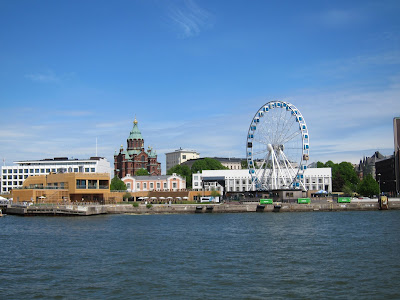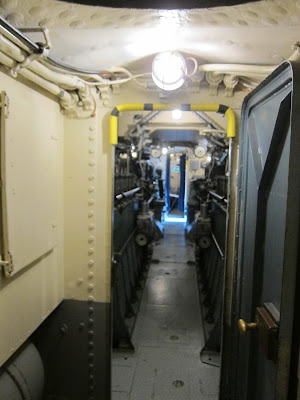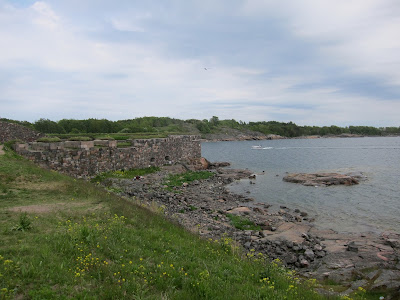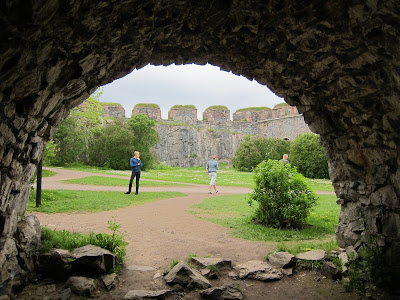We strolled down the Esplanade and stopped for pictures of statues, and for ice cream and coffee at an outdoor cafe.
Glass bottle player, he was quite good.
Beautiful statues, with arrogant pigeon.
Lovely park that runs alongside the Esplanade street. On the way to Market Square.
Shops and cafe on Esplanade, housed inside lovely buildings.
We had ice cream and coffee while sitting next to this fountain and pool.
Approaching Market Square. Those are the overhead lines for the trams. It's hard to get a picture without those in them. Still, public transportation is great, especially if you don't want to drive in the city.
Leaving Hesinki on the ferry.
We had bought a day pass for the public transportation system which is good for the train, buses, trams, and the ferry to Suomenlinna Sea Fortress.
"Founded in 1748 on a cluster of islands off the coast of Helsinki, its construction began in the 18th century, when Finland was still part of the Kingdom of Sweden. The guns that still face west on Kustaanmiekka island are a reminder of the period of the Russian rule in the 19th century."
The bridge from the main island to a small one that now houses the navy academy and barracks.
"Soumenlinna is an irregular bastion fortress constructed on uneven terrain and on separate islands. The fortress also has a special importance, having played a role in the defense of three states - Sweden, Russia, and Finland."
Part of the fortress wall and the tunnel to the naval academy and barracks.
Some views while crossing a bridge from the main island to the biggest island where we spent the most time. Here you can see the grass that is growing on top of the fortress walls and the man made caves in the wall. You can walk inside many of them and a lot of them are connected by small, narrow, dark passages.
"Soumenlinna is not only one of the foremost attractions in Finland, but also a lively community of some 800 residents. The fortifications and old garrison buildings have been restored and converted into residential properties, studios and offices, meeting and event facilities, restaurants and museums."
I really wanted to see the submarine since I've never had a chance to be inside one.
Vesikko is a Finnish submarine, built in the 1930s, that served in the Second World War.
It was extremely cramped in there. Visitors to this museum were squeezing past each other to take pictures.
The engine room. The Vesikko had both electric and diesel engines. The Siemens electric engines were run under the water. When the diesel engines were running it was incredibly hot, oily, and loud in the engine room. The sailors had to hold onto the rail with one hand while continuously pouring oil with the other hand. The floor was slippery and dangerous to walk upon.
Here I am, holding on to a rail in the engine room. Quiet now and with no oil and fumes. I can't imagine what it must have been like filled with men, smoke, noise, and heat.
The back. The black and white striping was to make the submarine harder to see in the water, from the air.
The middle. The yellow stripe is for the Germans who designed the submarine.
The front. The stair-step design, or jagged edges that you see are for cutting nets that were set in the sea to stop submarines.
The Vesikko had a crew of 20 men and only 16 berths, so the men worked in shifts. They were "volunteers" although they didn't always know WHAT they were volunteering for in the war. Some of the men would injure themselves while on leave so they didn't have to go back to the ship. It was so cramped that if a crewman in the front of the ship wanted to use the bathroom he would have to ask for permission from a crewman in the back (where the toilet was) to change positions with him on the ship.
The Germans designed the ship for Finland (hence the yellow stripe and the yellow circle on the deck, in honor of the German designers) and the Finnish built five submarines. The Vesikko was the only one to fire any torpedoes (there are three torpedo tubes) and they were only fired once. There were 1,000 torpedoes made for the five ships and they weren't ever used. After WWII, according to the Paris Accord, the Finnish were told that they could not own submarines or torpedoes, the other four were scrapped. The Vesikko was saved because the technology and mechanics were modern for its time. It was kept in storage until it was turned into a museum in the 1970s.
Torpedo tube.
We then went to Kustaanmiekka, our favorite part of this island.
Lots of walking up hill.
Looks like a Hobbit house doesn't it?
Nope, not a Hobbit house. They weren't even dwellings:
FORBIDDEN TO GO INSIDE THE FENCED AREAS!
There's a para sail behind there.
We walked on to the King's Gate and the King's Gate quay.
Para-sail.
It was cool and windy up there. That is the Finnish flag in the background and my handsome husband in the foreground.
The King's Gate.
View from the King's Gate.
There were lots of children and people inside of these, wandering between them through connecting tunnels.
At this point we stopped at a small cafe to have beers and I also had rhubarb cake. When we stepped outside it was raining so we went back inside the cafe and had pizza and wine and waited out the rain. It was cold inside the cafe but they had blankets you could use.
Luckily the rain didn't last long.
Returning to the main island.
This church has a working lighthouse on top.
The ferry ride back to Helsinki.
We then took tram #2&3 (it becomes tram #3 part way through the route and then back to tram #2) because it does a circle of the city and is a good, and cheap, way to see the sights. There is even a small guide you can get from the tourist office (TI) but the Rick Steves guide in his book is a better one.
After a long day of sightseeing it was nice to get on the train and go home.























































































No comments:
Post a Comment